- Apply
- Visit
- Request Info
- Give
Eye-Mind-Body: Drawing as Action
Far from simply a transcription of visual experience, drawing is both a phenomenal and a physical act; It uniquely engages Eye, Mind and Body. Whether epically large or intimately small, representational or abstract, intensely observational or kinetically performative, Drawing is a choreography of observation, interpretation and movement. It is direct and directed, but nevertheless contingent upon the vicissitudes of both mind and body, their inherent capacities and limitations.
Drawing is, in essence, creation in its pure, messy and imperfect form. It is elemental, and its fascination lies in its power to affirm the nascent image while declaring the presence of the mark-maker. The marks made are the trace, the footprints in the sand, attesting to a presence as well as the absence left behind in its passing.
Drawing as Action
A stylus, perhaps a stick of charcoal or graphite, is dragged across a surface, leaving a trail in its wake. More marks follow. Narrow and broad, tenuous or distinct, there might be no particular purpose or end product other than the act itself. This done, the marks might be obliterated, reduced to a fog of tones, mere shadows of their former self; and the process is begun again. The artist suppresses the impulse to render. Yet whether due to body mechanics or random imperfections in the surface itself, patterns do emerge suggesting forms in space. Some forms are reinforced by overdrawing. Certain propensities, such as a fascination with the human form, assert themselves. Nebulous figures coalesce from the shadows and smudges. They arise in much the same way that buried memories emerge from the labyrinths of the psyche. An image might be wiped down - not necessarily to eradicate it but rather in order to see it with fresh eyes, to avoid becoming overly enamored with what has already been done. Thus making room for further wanderings. Consequently, remnants of the previous patterns might re-assert themselves in unexpected ways, giving rise to a sense of wonder. All of these tracings join, becoming the matrix for new images or creating a dialogue between the older marks and the recent1. Since visual experience does not present itself to the human eye readily outlined, the process of drawing, that is representing or delineating, is, to paraphrase Derrida2, a blind venture into the depths of the unknown.
The tacit assertion is that drawing, even when representational, is a seminal act. And, in that respect it retains a degree of authenticity among the multitudinous array of images with which the contemporary world is overwhelmed and, ultimately, either ignores or worse yet incorporates into a fabricated reality based upon the myriad fictitious characters and events portrayed in the media3.
Initial viewing of a drawing reveals a visual text and perhaps subtexts. Subsequent encounters reveal the footnotes. Drawing does this unaided by the intervening filtration of the digital devices, computers, algorithms, or apps. The fact that drawing might make no pretense other than its own artifice renders drawing's power even more arresting. This power comes from having been actually touched by its maker. It is that maker’s ability to physically manipulate substances across the surface in order to create the illusion of a reality, be it literal or abstract, wherein lies drawing’s vital power. The act of rendering is at the mercy of the physical and emotional state of the practitioner, the sum of their experience as well as their bodily capacities and limitations and the awareness thereof. This process is uniquely and irreplicatibly sensual. Drawing is different each time it is attempted. Its genuineness can be artificially approximated by technology but not truly duplicated.
The oldest known drawing dates back 73,000 years. It was found in the Blombos Cave 200 miles from Cape Town, South Africa. At only an inch and a half the ochre marks are diminutive in size, however the implications are staggering in scale in that the Blombos discovery predates previous oldest drawings by nearly double the age. Yet, these primordial marks made by our sapien progenitors reach out across 73 millennia to touch us in the present.
Unlike, for example, photography or other media, whose interest more often lays in recording reality, the personality, identity or essence4 of its subject as well as with image resolution, drawing’s fascination, even when representational lays not only in the image produced but in that product’s constituent components, (i.e. lines, contours etc). Because the mark-maker (artist, draftsperson et al) recording, representing, vis-à-vis, without the intercession of the device ( camera, computer or other mechanical apparatus) he/she is no longer a passive witness to the perceptive process but rather now is an active participant. Thus they are Creator, creating something within the nothingness before them. Drawing is then an inherently exploratory and declarative act by which the mark-maker not only records and represents but also creates their own non-verbal, non-linguistic index or symbols relating to the visual and psychological experience of drawing, and engages directly with the subject and the medium. There are no machines, no intervening devices to come between the creator and the created. The drag of pencil against the surface is tactile, immediate, and real. Through direct touch the artist negotiates the drawing, it is also through this touch and the tactile as well as visual qualia that the drawing also communicates with the artist.
Mark Gerard McKee, Exhibition Curator and Designer, 2022
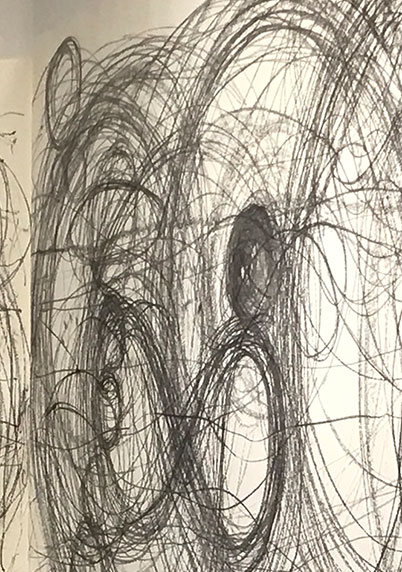
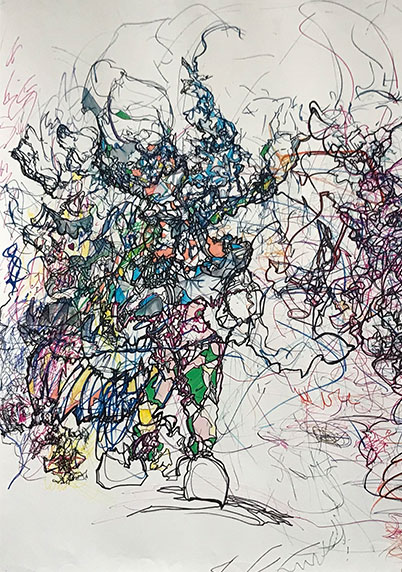
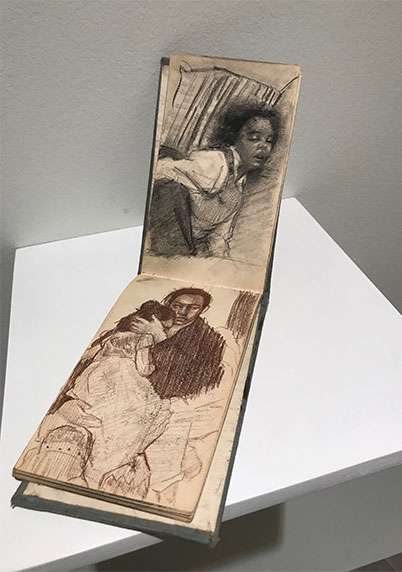
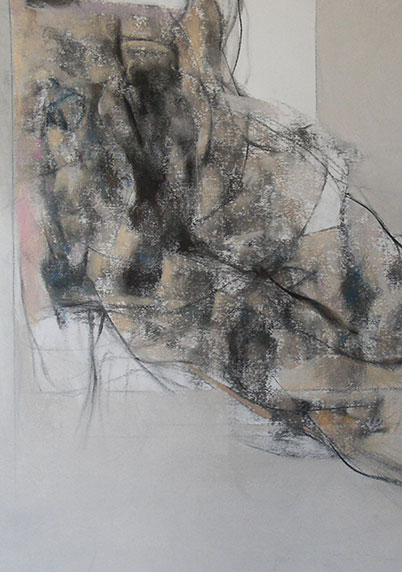
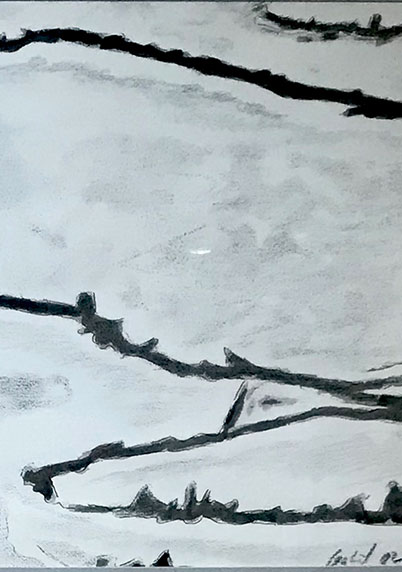
Endnotes:
1) In his article “Marks, Traces and Gestures of Drawing”’ Michael Newman discusses two manners in which the artist interacts with random marks or “stains”. In one the stain provides the suggestion of an image. In the second, the artist incorporates the stain itself into the drawing. In the drawing processes described throughout this paper, both of Newman’s descriptions of the stains and how the artist uses them are applicable. The assumptions are that the term “stain” applies to, A), any random or accidental ,mark or blemish made upon the ground, or B) any previous intentional mark made upon the ground incorporated into the drawing in a manner in which it was not originally intended.
2) In the first chapter of “On Pictures and the Words that Fail Them”, James Elkins: evokes Derrida’s “Memoirs of the Blind”, specifically this passage: “Even if drawing is, as they say, mimetic, that is, reproductive, figurative, representative, even if the model is presently facing the artist, the trait must proceed in the night. It escapes the field of vision.” Elkins goes on to add that, “This is a way of emphasizing the abyssal difference between the thing drawn and the drawing trait, which is, radically and definitively foreign to the phenomenality [sic] of the day; but the trait also bears the traces of vision and daylight, since the person making the mark will remember images, motions of the hand, and the
3) The reference here is to Jean Baudrillard’s “Simulacrum and Simulation”, In the extreme and by way of introducing his argument, he uses the analogy of the motion picture “The Matrix'', in which a technology driven society replaces reality and the direct experience there of, in favor of a computer simulation that is downloaded directly into the cerebral cortex of all the human inhabitants of the planet. These inhabitants, though fully believing their experiences are real, are, in fact, mere bodies, held in a suspected animation beneath the surface of a planet rendered uninhabitable by some catastrophic disaster. Their lives, sensory experiences, and culture are mere illusions, hallucinations created by a vast central computer “The Matrix”and fed directly into their collective consciousness. It is a world in which virtual reality has gone terribly wrong. He makes a direct analogy between the motion picture and the contemporary media. Baudrillard goes on to use several historical and cultural events, as well as politics’ and the media’s role in them throughout Simulacra and Simulation to illustrate his premise across a broad range of disciplines. Ultimately, we are faced with the paradox of whether we interact with and react to reality or our mere symbols of that now defunct reality and its simulations. As Baudrillard points out, this cycle of simulacrum and subsequent simulation now exists out of our control until, nature, or God, imposes actual catastrophe upon us, thus permitting us to experience the authentic. How this concept relates to the artist can be summed up in this query: Does the artist contribute to the continuance of the cycle of simulacrum or does the artist strive to illustrate the true nature of reality? If it is the latter, how best might the artist do so and what form should that illustration take? This is a purely rhetorical question. However, it cannot be answered by the critic, the art historian, or the institutions of art. This answer, it can be suggested, must come from each artist according to their nature and through the rigorous self-evaluation of their work and motivations.
4) In Roland Barthes’ “Camera Lucida,” the author describes certain attributes of the photograph. There is the “stadium” a general or average quality in which he is interested. In addition to this there is a special attribute that he describes as having the ability to prick or bruise him and there for makes some photos possessing this particular quality all the more poignant. To this quality he applies the term “punctum”.

